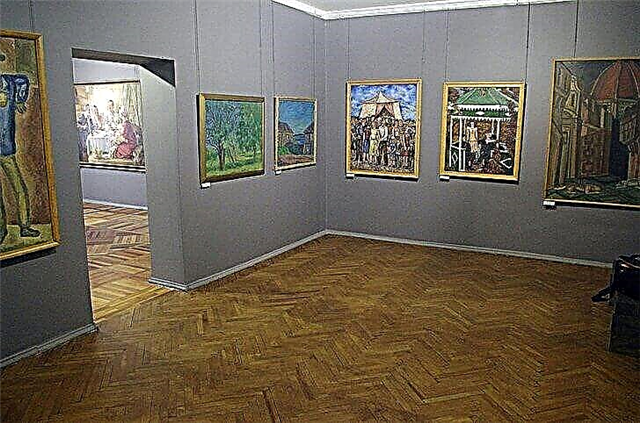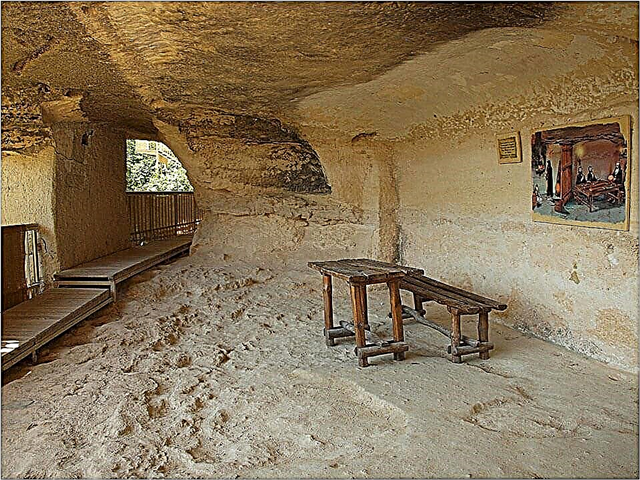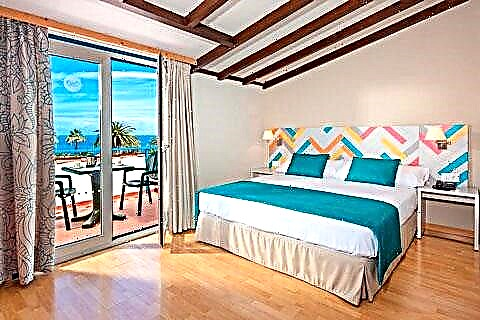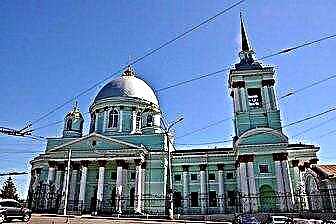Kursk is one of the spiritual and cultural centers of central Russia. The city was founded in the X century, since the XIV century it was part of the Grand Duchy of Lithuania, and at the beginning of the XVI was included in the territory of the Russian state. Tourists are waiting for magnificent architectural monuments - cathedrals, estates, monastic complexes, theaters, striking a variety of styles and built with the participation of talented craftsmen.
The most ambitious tourist site belongs to the events of the Second World War - it is an impressive memorial complex dedicated to the Battle of Kursk. If the city suddenly becomes bored, then you can go to the noble estates located several tens of kilometers away to take a walk in the parks and examine the lush interiors.

The best hotels and hotels at affordable prices.
from 500 rubles / day
What to see and where to go in Kursk?
The most interesting and beautiful places for walking. Photos and a short description.
Memorial complex "Kursk Bulge"
The Battle of the Kursk Bulge is one of the largest and most critical battles in the history of the Second World War. It was here, at the cost of thousands of lives, that the Soviet troops managed to reverse the rapid German offensive. A memorial complex in honor of this important event was opened in Kursk for the 55th anniversary of the Victory. The elements of the ensemble occupy an area of 600 m². The Kursk Bulge consists of a memorial museum, an obelisk, a triumphal arch, a model of a fighter, an Eternal Flame, a chapel, a mass grave and recreated artillery points from which the arrows fired. At the entrance to the complex there is a T-34 tank on a pedestal and a monument to Soviet tankmen.

Red Square
The central city square, on the site of which there was a fortress of the 17th century, residential buildings and the Resurrection Cathedral, destroyed by fire in 1781. The modern look of the square took shape in the 19th century, later it changed significantly due to the fact that many buildings were erected around in Soviet times. Many of these houses are now listed as architectural monuments.

Cathedral of the Sign
Orthodox church in the classical style, erected in honor of the victory in the Patriotic War of 1812. The building is very reminiscent of European Renaissance cathedrals - the same monumental dimensions, a huge round dome, symmetrical proportions and an entrance portal supported by columns. In the Soviet years, the building was converted into a cinema, having worked on its external appearance. After the return of the Russian Orthodox Church, the cathedral was reconstructed.

Voskresensko-Ilyinsky temple
The stone structure was erected in 1768, after 20 years it received the status of the main city temple. The church is a building with classical and baroque elements. Above the main building in the form of a rectangle rises an octagon crowned with a cross with a dome. Window openings are decorated with stucco elements. As a result of the last restoration, the church was painted in a pleasant pink color.

Sergiev-Kazan Cathedral
Temple of the XVIII century, built in the luxurious Elizabethan Baroque style, presumably by one of the representatives of the architectural school of B. Rastrelli. The building resembles a magnificent palace with orderly rows of wide windows, classic columns and decorative pilasters on the facade. In the center there is a 4-storey bell tower with a spire, on the side there is a two-storey quadrangle with a domed roof. The entrance is designed in the form of a Greek portico.

Church of the Assumption of the Virgin
Catholic church of the late 19th century, built in the neo-gothic style. In the period 1938–97. the temple did not work. In Soviet times, most of the original decoration was destroyed, and all valuables were confiscated. Later, the building was adapted as a museum of atheism and a warehouse. After the building was returned to the Catholic community, it was put in order, and it again shone with its magnificent architecture.

Holy Trinity Monastery
A women's monastery, presumably founded in the 17th century. Until 1680, all of its buildings were wooden, until they were destroyed by fire. The first stone church was laid in 1895. The monastery contains several miraculous icons of the Mother of God, as well as the relics of saints and saints of God. In Soviet times, the community was disbanded, but in the 1990s, the complex, which was badly dilapidated due to lack of proper care, was returned to believers.

Indigenous desert
Monastery for men, founded in the 17th century by decree of Tsar Fyodor Ioannovich on the site of the acquisition of the image of the Mother of God "The Sign". The monastery is located several tens of kilometers from Kursk. The desert is one of the most important pilgrimage centers in Russia. The picturesque buildings of the monastery - temples, gates, monuments and residential buildings are spread among meadows and forests on the high bank of the Tuskar River.

Kursk Museum of Local Lore
The museum was founded in 1903 on the initiative of the governor N. N. Gordeev. It was housed in the former bishops' chambers built in the 19th century. The exposition is a standard set for such institutions: archaeological and ethnographic artifacts, household items and household items, materials of the Great Patriotic War, photographs, antiques, paintings - more than 180 thousand items in total.

Kursk Museum of Archeology
The exposition opened in 1991. The first two years it was located on the first floor of the Lower Trinity Church, then it moved to a stone merchant mansion of the middle of the 18th century, erected in the manner of Moscow architecture. This is the only surviving building of that era that can be seen in Kursk. The collection consists of archaeological finds found in the Kursk region.

Drama Theater named after A.S. Pushkin
The Kursk Drama Stage is one of the oldest in Russia - it was founded in 1792. During its existence, the theater has changed several buildings. Today it is under construction in 1983. The name of A. Pushkin was given to the stage in 1937 in honor of the 100th anniversary of the poet. Today, performances are held in large and small halls, the repertoire consists of classical pieces and contemporary pieces.

Art Gallery named after A. A. Deineka
The City Art Gallery has a worthy collection that puts it on a par with Moscow art museums. The exhibition halls display works by European artists of the 16th – 21st centuries, works of Russian masters, sculptures, and decorative and applied art. The gallery's collection has taken part in international and all-Russian exhibitions many times.

Kursk State Puppet Theater
The institution was founded in 1944, but individual puppet shows, organized by a team of enthusiastic actors, have been staged in Kursk since 1935. Since 1965, the stage has been located in the building of the former women's gymnasium, built in the 1820s. The building is an architectural monument, erected in the eclectic style, combining the severity of classicism and the pretentiousness of the decorative elements of the Baroque.

Aquapark "Miracle Island"
Indoor water amusement park, which received its first visitors in 2008. The area of the complex is 600 m², at the same time the territory can accommodate up to 700 people. In addition to the standard slides and pools, a spa area with a jacuzzi and a salt cave is organized for a comfortable stay, artificial geysers and waterfalls decorating the space, and a bar is also open.

Monument to Kursk Antonovka
Antonovka is one of the most widespread varieties of apples in Russia, which appeared as a result of "folk selection". The monument in his honor was created in 2004 by the sculptor V.M.Klykov, who was the author of many famous monuments.The sculpture is made in the form of a giant apple weighing 150 kg and 2 meters high (inside the sculpture is hollow). The iron fruit bears complete resemblance to the present.

Building of the Noble Assembly
A luxurious three-storey building, a real palace with a richly decorated facade and an abundance of decorative details. The building was erected in 1877. Twice it was seriously damaged during fires, but each time it was restored. At various times, in addition to the Noble Assembly, the Workers' Palace, the Officers' House, the Railway Workers' Club, and a museum were located on its territory.

Main Directorate of the Central Bank for the Kursk Region
The structure, which today houses the Main Directorate of the Central Bank for the Kursk Region, was erected in 1913. It was built for the Peasant Land Bank. The unusual and picturesque mansion is an example of an eclectic style with predominantly Moorish motives, as if it had miraculously moved to Kursk from the vastness of Spanish Andalusia. After a major overhaul, the building became a decoration of the city.

Railway station building
The city railway station was opened in 1868. The modern building was erected in the 1950s according to the design of I. G. Yavein. The building was built in the style of the monumental Stalinist Empire style. The central facade of rich red color is decorated with heavy stucco molding, the coat of arms of the USSR, as well as figures of soldiers and workers, are placed above the main arch of the entrance. There are memorial plaques on the rear façade facing the paths.

The estate of Count Nelidov
The mansion was erected in the 19th century for the famous Russian nobleman - Count A.I. Nelidov, who served as the head of the Kursk province. A picturesque park with artificial ponds and apple orchards was organized around the estate. Nowadays, the estate houses the sanatorium "Moskva", which is engaged in the maintenance and spot restoration of an architectural monument.

Estate of Maryino
The palace and park ensemble is located 100 km from Kursk. It is a complex of buildings from the early 19th century, surrounded by a landscape park. It includes the main house and a number of utility rooms. To explore the luxurious interiors, you need to join an organized tour; you can walk around the park on your own if you purchase an entrance ticket.












